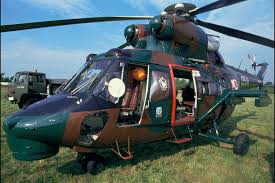
In 1979, with nearly 20 years experience of building Mil-designed helicopters behind it, Poland's PZL Swidnik flew the first prototype of a new design designated W-3 and named Sokol (Flacon). There was a long series of tethered tests and extensive design changes before the second prototype flew in May 1982, and it was another three years before production began. Since then, PZL has developed several specialized variants for military and civil applications. By 1996 PZL had completed more than 80 production W-3s, including 12 for Myanmar. Others were built for the Polish armed forces and government agencies, and included naval, fire-fighting and search and rescue (SAR) models.
Known as the Anakonda, the W-3RM is a rescue variant with flotation bags, a watertight cabin and a winch. The W-3U-1 Alligator was proposed for the anti-submarine role, but the planned W-3 Sokol-Long, with a stretch fuselage seating up to 14 fully armed troops, was discontinued in 1993.
W-3s have been fitted with several different weapons, including AT-6 Spiral anti-tank and SA-7 Grail anti-aircraft missiles, 20-mm and 23-mm cannon, and rocket launchers. At one stage, the manufacturer teamed with Kentron of South Africa to offer an export version with weapons systems similar to those of the Denel AH-2 Rooivalk, but the partnership failed in 1994.
In its basic transport form, the W-3 has removable seats and can be used to carry cargo or casualties as an alternative to passengers. Only one example of the armed W-3 Huzar has been completed, but development is continuing.





 მთავარი გვერდი
მთავარი გვერდი თამაშები
თამაშები



